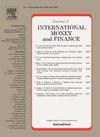Real exchange rate, financial constraints and product innovation: Evidence from China
IF 3.3
2区 经济学
Q2 BUSINESS, FINANCE
引用次数: 0
Abstract
This paper examines how real exchange rate (RER) movements affects product innovation using a panel dataset of Chinese manufacturing firms. We construct a firm-specific effective RER to reflect each firm’s unique exposure to exchange rate shocks based on its composition of trading partners. Product innovation is measured by the share of new product sales in total sales (NPS), an indicator that reflects the successful commercialization of product innovation. Our main results report that RER appreciation reduces NPS. We further hypothesize that decreased profits from diminished exports, induced by RER appreciation, tighten financial constraints on developing new products. Empirical evidence supports this hypothesis: the negative effect of RER appreciation on NPS is more pronounced for financially constrained firms, specifically those with private ownerships, less fixed assets, a lower current ratio, a lower net liquidity ratio, or those located in cities with lower levels of financial development.
实际汇率、金融约束与产品创新:来自中国的证据
本文利用中国制造业企业的面板数据集,考察了实际汇率变动对产品创新的影响。我们构建了一个企业特定的有效RER,以反映每个企业基于其贸易伙伴组成的独特的汇率冲击风险。产品创新是通过新产品销售额占总销售额的比重(NPS)来衡量的,这是反映产品创新成功商业化的指标。我们的主要结果报告了RER升值降低了NPS。我们进一步假设,由于RER升值导致的出口利润减少,对开发新产品的资金限制更加严格。经验证据支持这一假设:对于资金受限的企业,特别是那些私有企业、固定资产较少、流动比率较低、净流动性比率较低的企业,或者那些位于金融发展水平较低城市的企业,RER升值对NPS的负面影响更为明显。
本文章由计算机程序翻译,如有差异,请以英文原文为准。
求助全文
约1分钟内获得全文
求助全文
来源期刊

Journal of International Money and Finance
BUSINESS, FINANCE-
CiteScore
4.20
自引率
4.00%
发文量
141
期刊介绍:
Since its launch in 1982, Journal of International Money and Finance has built up a solid reputation as a high quality scholarly journal devoted to theoretical and empirical research in the fields of international monetary economics, international finance, and the rapidly developing overlap area between the two. Researchers in these areas, and financial market professionals too, pay attention to the articles that the journal publishes. Authors published in the journal are in the forefront of scholarly research on exchange rate behaviour, foreign exchange options, international capital markets, international monetary and fiscal policy, international transmission and related questions.
 求助内容:
求助内容: 应助结果提醒方式:
应助结果提醒方式:


